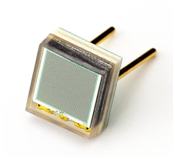Developing improved ways to detect particle losses

Beam Loss Monitoring (BLM) using Cherenkov fibres and Silicon photo multipliers (SiPMs) is a relatively new approach. It promises access to more precise information about the time and spatial distribution of losses of charged particles along a beam line at lower costs in comparison with more conventional technique. However, this is rather challenging application for SiPMs as it requires the reconstruction of a Cherenkov light signal with an unknown initial waveform from the SiPM response. Sofar, this has been well-studied only for the case of single short and weak light pulses.
In order to provide further insight into the features of transient SiPM response on complex BLM signals including high intensity ones, several members of the QUASAR Group (Dr. Eduardo Nebot del Busto, Maria Kastriotou, Lee Devlin, and Dr. Sergey Vinogradov) started a new series of experimental studies at the Cockcroft Institute and CERN. An important experiment has been carried out between 13 – 17 October 2014 when Dr. Vinogradov visited CERN.
The experiment has been developed in such a way to reproduce Cherenkov light signals from two different locations of beam losses, separated from each other in a range from 30 cm to 100 m (the typical Cherenkov fibre length for such application is expected to be of the order of 100 m). Light for this experiment was delivered by two high precision PicoQuant lasers of 60 ps pulse width FWHM with a variable delay between pulses from 1 ns to 300 ns. This corresponds to the above distances, as 100 m ~ 300 ns. The itensity of the laser pulses was varied over a wide range up to a complete saturation of the SiPM response. The data is currently being analysed and full details are expected to be published soon.
At the end of his visit Dr. Vinogradov gave a talk as part of CERN’s Beam Instrumentation seminar on Friday 17th October on "Probabilistic analysis of SiPM performance in calorimetric, time of flight, and beam loss monitoring applications". In his presentation he discussed SiPM performance in a variety of applications in accelerator and particle physics, including the latest updates on BLM using SiPMs.